One-Time Contact Application of Controlled-Release Urea and Optimized Method Improved Rice Yield and Nitrogen Use Efficiency with 50% Nitrogen Input
Abstract
1. Introduction
2. Materials and Methods
2.1. Test Materials
2.2. Experimental Design
2.3. Sampling and Measurements
2.3.1. Seedling Quality
2.3.2. Rate of Emergence and Plant Height
2.3.3. Root Breaking Rate
2.3.4. SPAD Value, Plant Height, Number of Tillers, and Leaf Area Index
2.3.5. Determination of Leaf Enzyme Levels
2.3.6. Yield and Yield Formation
2.3.7. Nitrogen Partial Factor Productivity
2.4. Statistical Analysis
3. Results
3.1. Effects of Controlled-Release Urea Contact Application on Rice Seedling Growth and Seedling Quality
3.2. Effects of Controlled-Release Urea Contact Application on Plant Height and Number of Tillers of Rice in Different Growth Stages
3.3. Effects of Controlled-Release Urea Contact Application on Leaf Area Index of Rice in Different Growth Stages
3.4. Effects of Controlled-Release Urea Contact Application on SPAD in Different Growth Stages of Rice
3.5. Effects of Controlled-Release Urea Contact Application on Leaf Enzyme Levels in Different Growth Stages of Rice
3.6. Yield and N Partial Productivity under Each Treatment
4. Discussion
4.1. Quality of Seedlings under Contact Fertilization and Optimal Management of Controlled-Release Fertilizers
4.2. Effects of Contact Fertilization and Optimal Management of Controlled-Release Fertilizers on N Transferase Level, SPAD Value, and Photosynthetic Rate of Rice
5. Conclusions
Supplementary Materials
Author Contributions
Funding
Data Availability Statement
Acknowledgments
Conflicts of Interest
Abbreviations
| NBTF | nursery-box total fertilization |
| N | nitrogen |
| S0 | the order being “soil + fertilizer + seed + soil” |
| S | the order being “soil mixture + seed + soil” |
| B | common seedling tray |
| BT | Boxingtanzhuang (in Chinese) seedling tray |
| FFP | farmers’ familiar practice |
| CRU | Controlled-release urea |
| SPAD | soil and plant analyzer development. The SPAD value is usually used to indicate the chlorophyll content in the handheld chlorophyll meter, and SPAD is actually the abbreviation of the “Soil and Plant Analyzer Development” of the Agriculture and Horticulture Bureau of the Ministry of Agriculture, Forestry, and Fisheries of Japan. The Japanese are accustomed to using leaf color to study crop yield, quality, and fertilization management, so the SPAD chlorophyll meter is called the leaf color meter, and the SPAD readings are called leaf color values. In practical application, it is found that the chlorophyll content of plants is positively correlated with the SPAD value (SPAD readings). |
References
- Sun, T.; Yang, X.; Tan, X.; Han, K.; Tang, S.; Tong, W.; Zhu, S.; Hu, Z.; Wu, L. Comparison of agronomic performance between japonica/indica hybrid and japonica cultivars of rice based on different nitrogen rates. Agronomy 2020, 10, 171. [Google Scholar] [CrossRef]
- Champagne, E.T.; Bett-Garber, K.L.; Thomson, J.L.; Fitzgerald, M.A. Unraveling the impact of nitrogen nutrition on cooked rice flavor and texture. Cereal Chem. 2009, 86, 274–280. [Google Scholar] [CrossRef]
- Ma, G.H.; Yuan, L.P. Hybrid rice achievements, development and prospect in China. J. Integr. Agric. 2015, 14, 197–205. [Google Scholar] [CrossRef]
- IFA. Fertilizer Use by Crop and Country for the 2017–2018 Period; IFA: Paris, France, 2022; pp. 9–10. [Google Scholar]
- Zhang, F.S.; Wang, J.Q.; Zhang, W.F.; Cui, Z.L.; Ma, W.Q.; Chen, X.P.; Jiang, R.F. Nutrient use efficiencies of major cereal crops in China and measures for improvement. Acta Pedol. Sin. 2008, 45, 915–924. (In Chinese) [Google Scholar]
- Xing, Y.; Claudia, K.; Yu, Z.; Alex, N.; Feike, A. Global meta-analysis of nitrogen fertilizer use efficiency in rice, wheat and maize. Agric. Ecosyst. Environ. 2022, 338, 108089. [Google Scholar]
- Li, W.W.; Ahmad, S.; Liu, D.; Gao, S.; Wang, Y.H.; Tao, W.K.; Chen, L.; Liu, Z.H.; Jiang, Y.; Li, G.H.; et al. Subsurface banding of blended controlled-release urea can optimize rice yields while minimizing yield-scaled greenhouse gas emissions. Crop J. 2023, 11, 914–921. [Google Scholar] [CrossRef]
- Ding, Z.J.; Li, J.T.; Hu, R.; Xia, D.K.; Huang, F.; Peng, S.; Huang, J.L.; Li, C.F.; Hou, J.; Tian, Y.B.; et al. Root-zone fertilization of controlled-release urea reduces nitrous oxide emissions and ammonia volatilization under two irrigation practices in a ratoon rice field. Field Crops Res. 2022, 2287, 108673. [Google Scholar] [CrossRef]
- Tian, C.; Sun, M.X.; Zhou, X.; Li, J.; Xie, G.X.; Yang, X.D.; Peng, J.W. Increase in yield and nitrogen use efficiency of double rice with long-term application of controlled-release urea. J. Integr. Agric. 2022, 21, 2106–2118. [Google Scholar] [CrossRef]
- Lan, T.; Li, M.X.; Han, Y.; Deng, O.P.; Tang, X.Y.; Luo, L.; Zeng, J.; Chen, J.D.; Yu, S.; Wang, C.Q.; et al. How are annual CH4, N2O, and NO emissions from rice–wheat system affected by nitrogen fertilizer rate and type? Appl. Soil Ecol. 2020, 150, 103469. [Google Scholar] [CrossRef]
- Zhang, A.P.; Gao, J.; Liu, R.L.; Chen, Z.; Yang, S.; Yang, Z.; Shao, H.; Zhang, Q.; Yoshikazu, N. Nursery-box total fertilization technology application for increasing nitrogen use efficiency in Chinese irrigated riceland: N-soil interactions. Land Degrad. Dev. 2016, 27, 1255–1265. [Google Scholar] [CrossRef]
- Yang, Y.C.; Zhang, M.; Li, Y.C.; Fan, X.; Geng, Y. Controlled-release urea commingled with rice seeds reduced emission of ammonia and nitrous oxide in rice paddy soil. J. Environ. Qual. 2013, 42, 1661. [Google Scholar] [CrossRef] [PubMed]
- Li, J.T.; Hu, Y.; Li, X.; Ding, Z.J.; Yang, S.; Nie, X.B.; Huang, F.; Hou, J.; Cao, B. The effect of controlled release urea contact application on the growth of rice seedlings. Chin. J. Soil Fertil. 2023, 01, 57–64. (In Chinese) [Google Scholar]
- Yang Yue, C.; Zhang, M.; Chen, J.Q.; Duan, L.L.; Geng, Y.Q.; Zheng, L. Effects of controlled release nitrogen fertilizer on morphological and physiological characteristics of rice seedlings. Plant Nutr. Fertil. Sci. 2010, 16, 1126–1135. (In Chinese) [Google Scholar]
- Chen, H.Z.; Xu, Y.C.; Zhang, Y.P.; Xiang, J.; Zhang, Y.K.; Zhu, D.F. Mechanical transplanting effect and yield formation of super early rice pot blanket seedlings. Sci. Agric. Sin. 2019, 52, 4240–4250. (In Chinese) [Google Scholar]
- Ye, C.; Li, Y.D.; Cao, Z.S.; Huang, J.B.; Sun, B.F.; Shu, S.F.; Wu, L.F. Effects of different seedling trays on plant type and yield of double-cropping rice. Chin. J. Rice Sci. 2020, 34, 435–442. (In Chinese) [Google Scholar]
- Erinaldo, G.; Brisa, R.; Layzza, R.; St’efanny, A.; Carlos, A.; Leandro, A.; Manlio, S.; Claudia, A. Nutripriming with ammonium nitrate improves emergence and root architecture and promotes an increase in nitrogen content in upland rice seedlings. Biocatal. Agric. Biotechnol. 2022, 42, 102331. [Google Scholar]
- Nitika, S.; Sushil, R.; Vikas, K.; Pallavi, S.; Santosh, K.; Singh, S.; Surya, K.; Madhav, P.; Ram, B.; Rajeev, K. Deciphering the genetic basis of root morphology, nutrient uptake, yield, and yield-related traits in rice under dry direct-seeded cultivation systems. Sci. Rep. 2019, 9, 9334. [Google Scholar]
- Sadiah, S.; Insha, S.; Aaqif, Z.; Sajad, M.; Asif, B.; Anuj, R.; Prasad, P.V.V.; Parvaze, A. The resilience of rice under water stress will be driven by better roots: Evidence from root phenotyping, physiological, and yield experiments. Plant Stress 2023, 10, 100211. [Google Scholar]
- Liu, Q.H.; Wu, X.S.; Ma, J.Q.; Chen, B.C.; Xin, C.Y. Effects of delaying transplanting on agronomic traits and grain yield of rice under mechanical transplantation pattern. PLoS ONE 2015, 10, e0123330. [Google Scholar] [CrossRef] [PubMed]
- Pinson, S.R.M.; Jia, Y.L. QTLs for early tiller production and relationships with rapid seedling growth and increased panicle number in rice. Crop Sci. 2016, 56, 505–519. [Google Scholar] [CrossRef]
- Tomomi, A.; Masataka, W.; Akira, K.; Mitsuhiro, O.; Hiroaki, K.; Tetsuya, M.; Naohiro, A.; Ryu, O. Changes in nitrogen assimilation, metabolism, and growth in transgenic rice plants expressing a fungal NADP(H)-dependent glutamate dehydrogenase (gdhA). Planta 2010, 232, 299–311. [Google Scholar]
- Lu, Y.; Luo, F.; Yang, M.; Li, X.H.; Lian, X.M. Suppression of glutamate synthase genes significantly affects carbon and nitrogen metabolism in rice (Oryza sativa L.). Sci. China Life Sci. 2011, 54, 651–663. [Google Scholar] [CrossRef] [PubMed]
- Kronzucker, H.J.; Kirk, G.J.D.; Siddiqi, M.Y.; Glass, A.D.M. Effects of hypoxia on 13NH4+ fluxes in rice roots. Plant Physiol. 1998, 116, 581–587. [Google Scholar] [CrossRef] [PubMed]
- Zhang, Z.; Wang, Y.F.; Wang, Z.M.; Ashraf, U.; Mo, Z.M.; Tian, H.; Duan, M.Y.; Li, Y.Q.; Tang, X.R.; Pan, S.G. Precise delivery of nitrogen at tillering stage enhances grain yield and nitrogen use efficiency in double rice cropping systems of South China. Field Crops Res. 2022, 289, 108736. [Google Scholar] [CrossRef]
- Arvind, K.S.; Ladha, J.K.; Vinod, K.S.; Dwivedi, B.S.; Balasubramanian, V.; Raj, K.G.; Seema, S.; Yashvir, S.; Himanshu, P.; Pragya, P.; et al. Calibrating the Leaf Color Chart for Nitrogen Management in Different Genotypes of Rice and Wheat in a Systems Perspective. Agron. J. 2004, 96, 1606–1621. [Google Scholar]
- Du, B.; Luo, H.W.; He, L.X.; Zheng, A.X.; Chen, Y.L.; Zhang, T.T.; Wang, Z.M.; Hu, L.; Tang, X.R. Deep fertilizer placement improves rice growth and yield in zero tillage. Appl. Ecol. Environ. Res. 2018, 16, 8045–8054. [Google Scholar] [CrossRef]
- Chen, Y.Y.; Fan, P.S.; Mo, Z.W.; Kong, L.L.; Tian, H.; Duan, M.Y.; Li, L.; Wu, L.J.; Wang, Z.M.; Tang, X.R.; et al. Deep placement of nitrogen fertilizer affects grain yield, nitrogen recovery efficiency, and root characteristics in direct seeded rice in South China. J. Plant Growth Regul. 2021, 40, 379–387. [Google Scholar] [CrossRef]
- Wang, D.Y.; Xu, C.M.; Ye, C.; Chen, S.; Chu, G.; Zhang, X.F. Low recovery efficiency of basal fertilizer-N in plants does not indicate high basal fertilizer-N loss from split-applied N in transplanted rice. Field Crops Res. 2018, 229, 8–16. [Google Scholar] [CrossRef]
- He, W.; He, B.; Wu, B.Y.; Yu-hui, W.A.N.G.; Yan, F.F.; Ding, Y.F.; Li, G.H. Growth of tandem long-mat rice seedlings using controlled release fertilizers: Mechanical transplantation could be more economical and high yielding. J. Integr. Agric. 2023, 22, 3652–3666. [Google Scholar] [CrossRef]
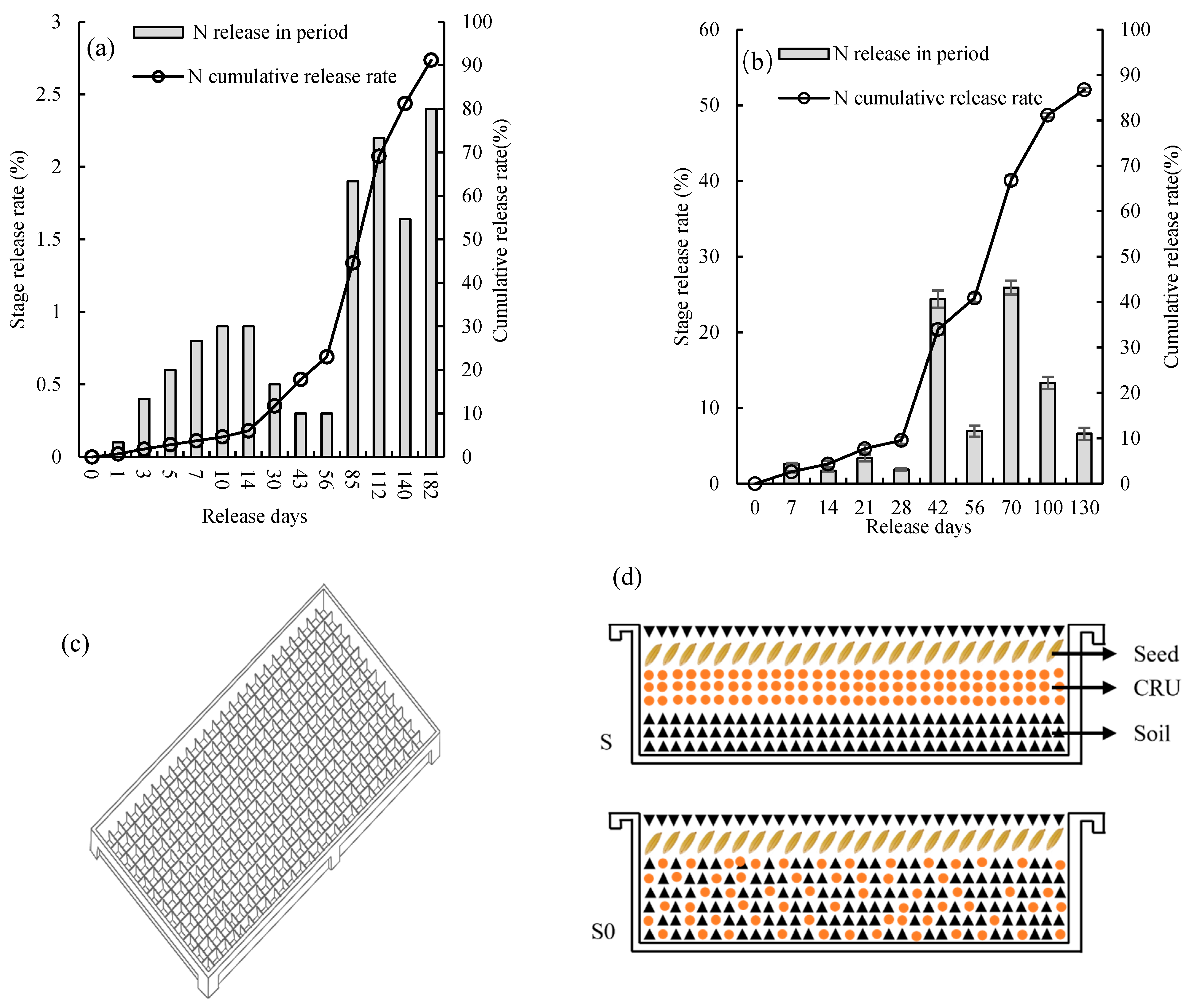
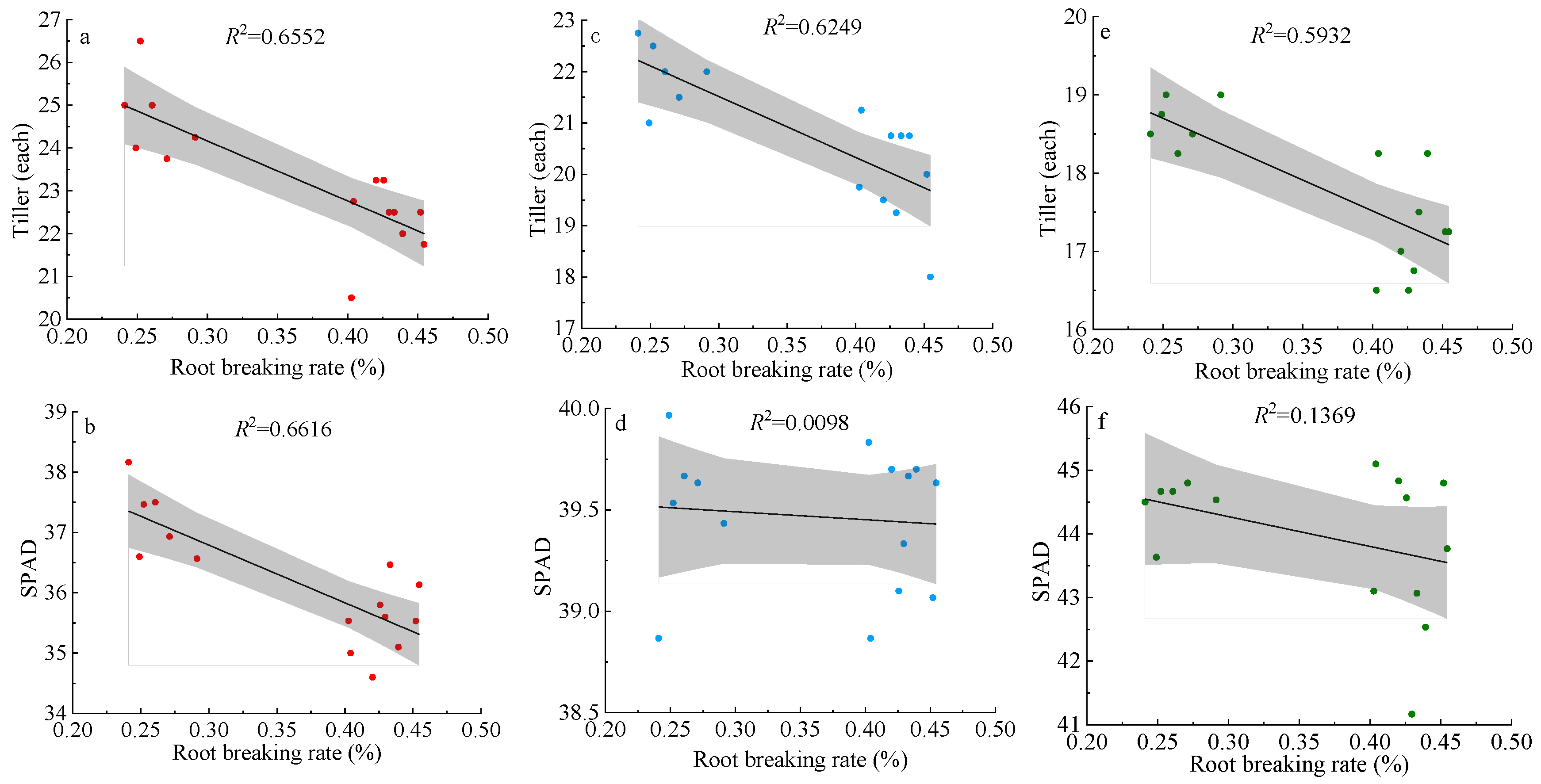

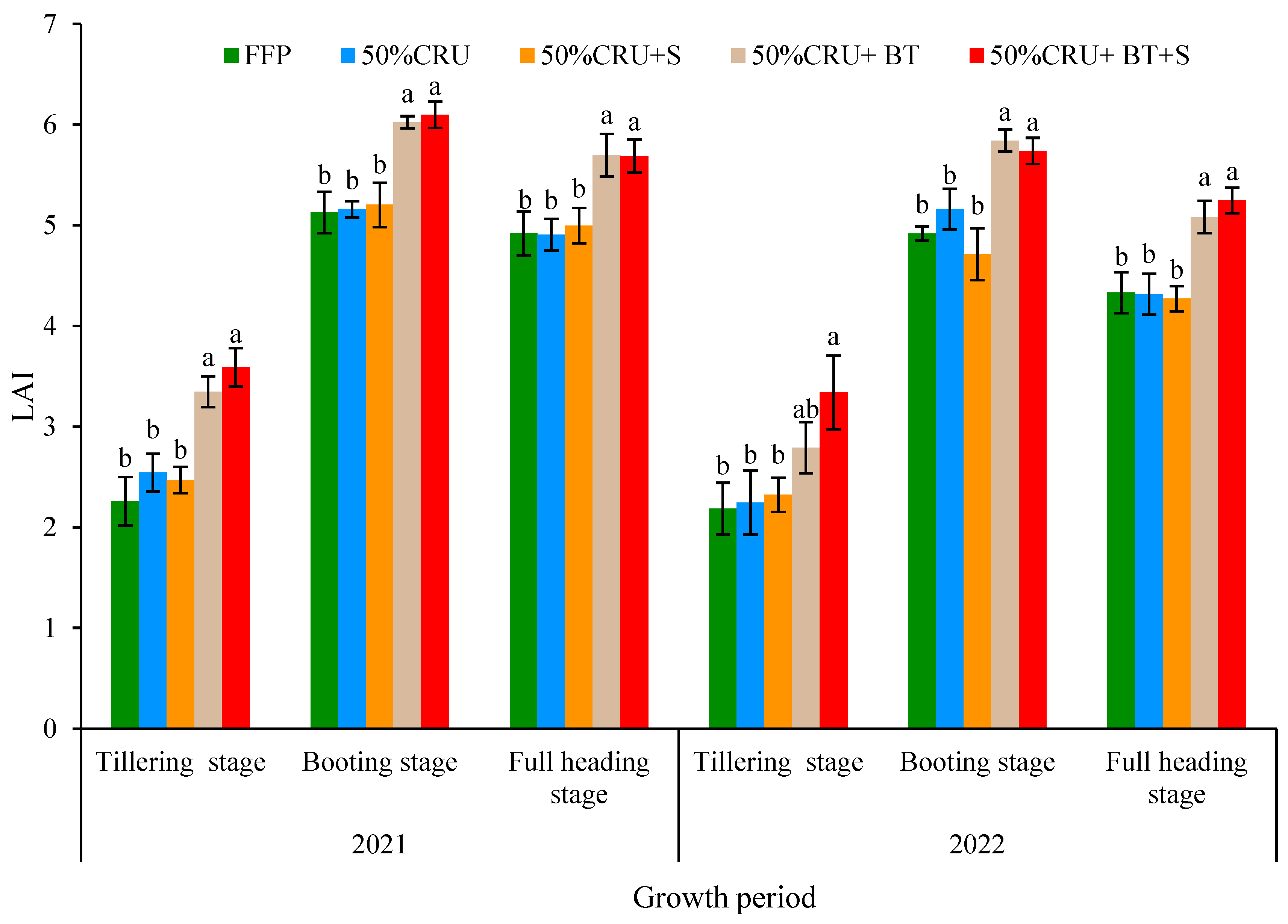
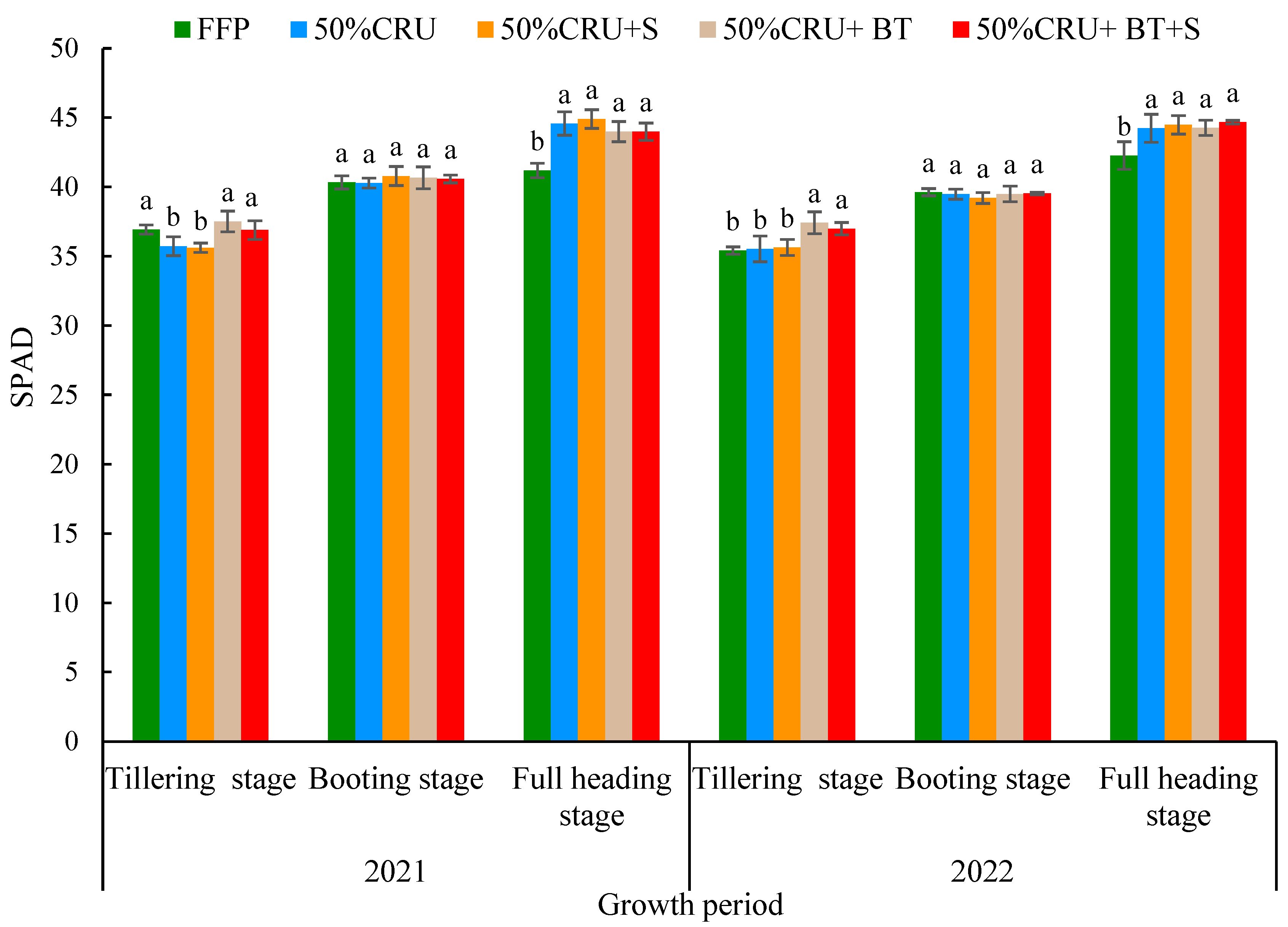
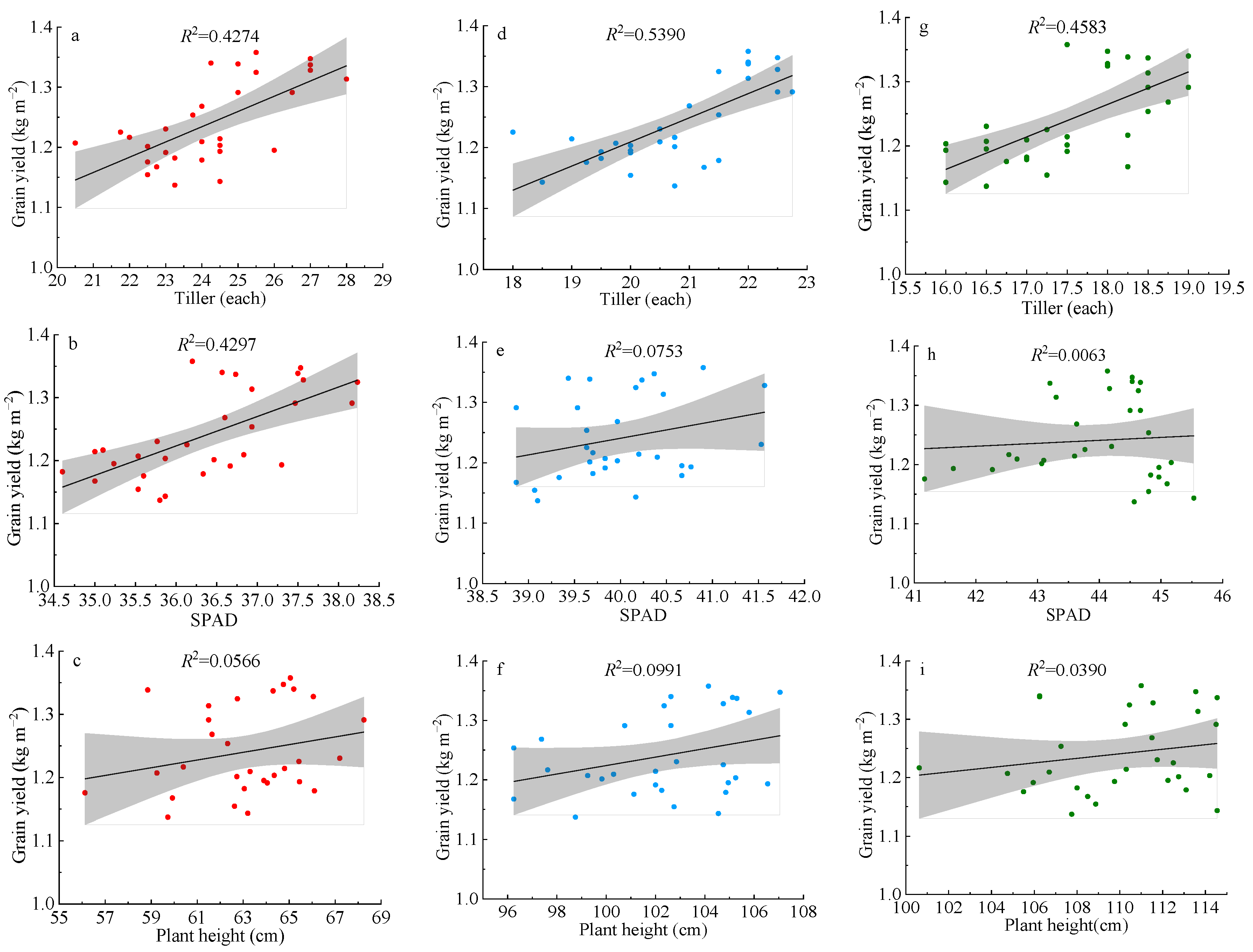
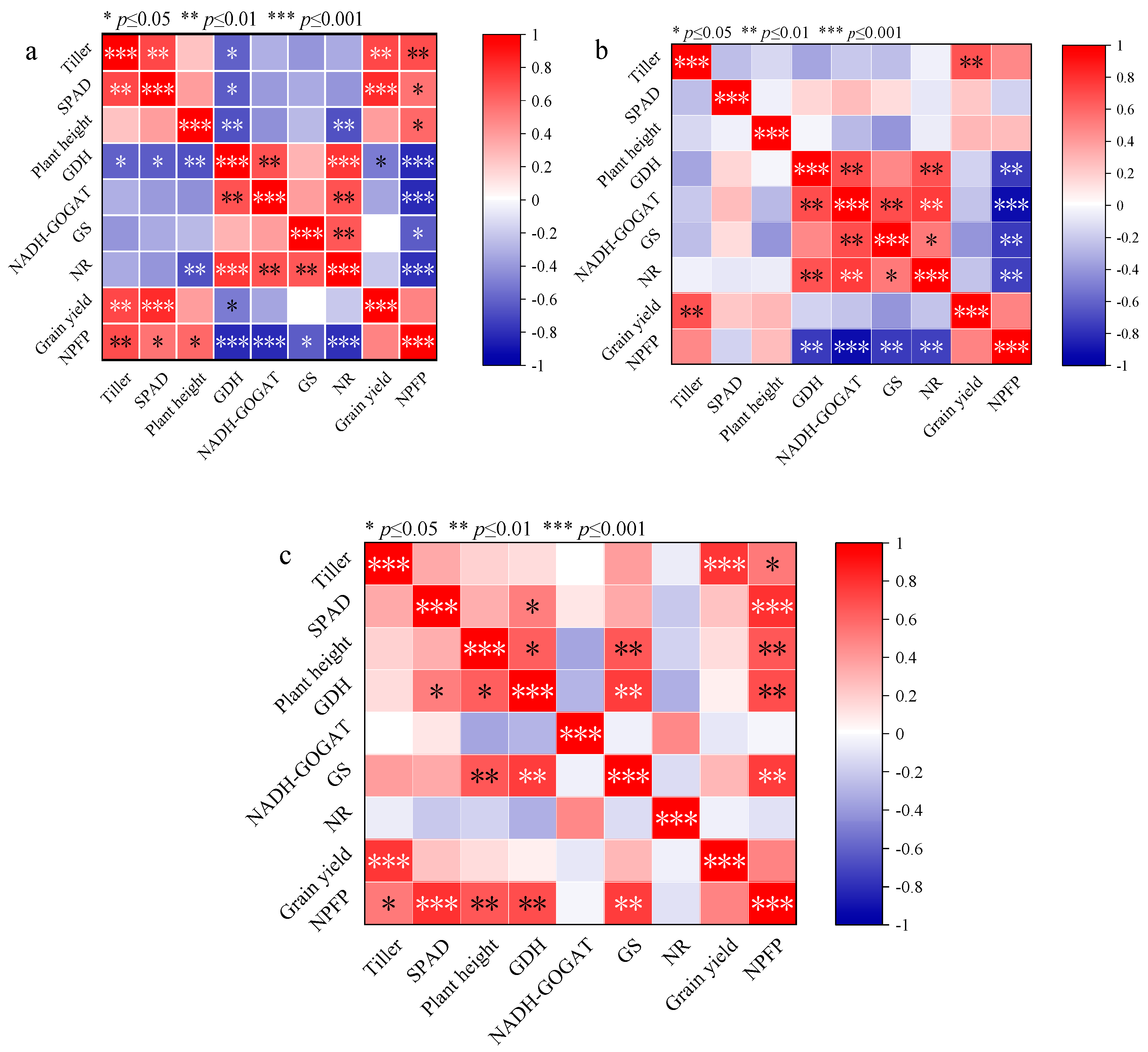
| Treatment | Seedling Stage | |||||
| Fertilizer Application Method | Amount of Controlled-Release Urea per Plate | N Application Rate | Nursery Tray | Filling Method for Seedling Soil | ||
| (g) | (kg ha−1) | |||||
| FFP | Conventional fertilization | - | - | B | S0 | |
| 50%CRU | CRU contact fertilization | 755 | 90 | B | S0 | |
| 50%CRU + S | CRU contact fertilization | 755 | 90 | B | S | |
| 50%CRU + BT | CRU contact fertilization | 755 | 90 | BT | S0 | |
| 50%CRU + BT + S | CRU contact fertilization | 755 | 90 | BT | S | |
| Treatment | Micro-Plot Growth Stage | |||||
| Base Fertilizer | Tillering Fertilizer | Fertilization for Head Sprouting | N Application Method | |||
| (g plot−1) | (g plot−1) | (g plot−1) | ||||
| Urea | Calcium Superphosphate | Potassium Chloride | Urea | Urea | ||
| (P2O5, 12%) | (K2O, 60%) | |||||
| FFP | 3.52 | 13.5 | 3.6 | 2.12 | 1.4 | 3 times |
| 50%CRU | - | 13.5 | 3.6 | - | - | 1 time |
| 50%CRU + S | 1 time | |||||
| 50%CRU + BT | - | 13.5 | 3.6 | - | - | 1 time |
| 50%CRU + BT + S | - | 13.5 | 3.6 | - | - | 1 time |
| Treatment | Rate of Emergence (%) | Plant Height (cm) | Root Breaking Rate (%) | Above Ground Dry Weight (mg) | Fullness | Seedling Index | Uniformity (%) |
|---|---|---|---|---|---|---|---|
| FFP | 88.68% ± 0.01 a * | 11.37 ± 0.42 b | 42.38% ± 0.02 a | 12.87 ± 0.26 b | 0.11 ± 0.01 c | 0.20 ± 0.02 b | 90.63% ± 0.01 a |
| 50% CRU | 79.35% ± 0.01 b | 13.39 ± 0.83 a | 43.51% ± 0.02 a | 22.71 ± 1.10 a | 0.17 ± 0.01 ab | 0.34 ± 0.02 a | 87.21% ± 0.01 b |
| 50% CRU + S | 79.15% ± 0.03 b | 13.34 ± 0.30 a | 42.81% ± 0.03 a | 23.32 ± 0.92 a | 0.18 ± 0.01 a | 0.28 ± 0.07 a | 86.18% ± 0.01 b |
| 50% CRU + BT | 78.15% ± 0.02 b | 14.16 ± 0.29 a | 25.02% ± 0.01 b | 22.56 ± 1.27 a | 0.16 ± 0.01 ab | 0.28 ± 0.03 a | 86.58% ± 0.02 b |
| 50% CRU + BT + S | 81.82% ± 0.05 b | 13.95 ± 0.82 a | 27.15% ± 0.02 b | 22.91 ± 1.19 a | 0.16 ± 0.01 ab | 0.29 ± 0.03 a | 87.06% ± 0.02 b |
| Growth Period | Treatment | GDH (nmol min−1 g−1) | NADH-GOGAT (nmol min−1 g−1) | GS (μmol h−1 g−1) | NR (nmol min−1 g−1) |
|---|---|---|---|---|---|
| Tillering stage | FFP | 286.5 ± 4.28 a * | 387.7 ± 6.83 a | 17.77 ± 0.75 a | 775.9 ± 6.91 a |
| 50% CRU | 270.3 ± 8.96 b | 366.9 ± 7.49 b | 15.65 ± 0.46 b | 750.3 ± 7.44 b | |
| 50% CRU + S | 272.5 ± 6.55 b | 358.8 ± 9.48 b | 15.27 ± 1.14 b | 751.3 ± 8.33 b | |
| 50% CRU + BT | 265.7 ± 5.43 b | 358.3 ± 8.81 b | 15.51 ± 0.63 b | 754.7 ± 8.69 b | |
| 50% CRU + BT + S | 264.6 ± 8.94 b | 364.3 ± 7.99 b | 15.67 ± 1.90 b | 748.1 ± 7.27 b | |
| Booting stage | FFP | 364.6 ± 7.83 a | 461.1 ± 7.43 a | 30.46 ± 0.78 a | 426.5 ± 8.06 a |
| 50% CRU | 341.2 ± 11.50 b | 417.6 ± 9.90 b | 26.37 ± 1.62 b | 406.6 ± 7.10 b | |
| 50% CRU + S | 344.6 ± 10.55 b | 416.2 ± 7.25 b | 25.97 ± 2.62 b | 406.3 ± 11.26 b | |
| 50% CRU + BT | 341.8 ± 6.77 b | 417.6 ± 9.50 b | 25.25 ± 1.18 b | 402.2 ± 7.48 b | |
| 50% CRU + BT + S | 340.8 ± 2.17 b | 418.1 ± 2.65 b | 25.87 ± 3.23 b | 404.4 ± 12.21 b | |
| Full heading stage | FFP | 449.01 ± 5.76 b | 524.3 ± 5.29 a | 33.29 ± 1.55 b | 331.1 ± 7.14 a |
| 50% CRU | 473.7 ± 7.89 a | 524.6 ± 8.16 a | 37.36 ± 12.26 a | 328.3 ± 4.30 a | |
| 50% CRU + S | 476.4 ± 8.95 a | 527.1 ± 9.84 a | 36.00 ± 1.04 a | 331.6 ± 7.68 a | |
| 50% CRU + BT | 471.7 ± 12.05 a | 521.2 ± 7.67 a | 36.59 ± 0.62 a | 330.0 ± 4.99 a | |
| 50% CRU + BT + S | 469.3 ± 13.10 a | 524.0 ± 11.76 a | 36.68 ± 0.86 a | 327.9 ± 5.38 a |
| Year | Treatment | Panicle Number | Number of Grains per Panicle | TGW (g) | Grain Yield (kg m−2) | NPFP(kg kg−1) |
|---|---|---|---|---|---|---|
| 2021 | CK | 15.83 ± 0.58 b * | 207.1 ± 1.72 a | 23.36 ± 0.39 a | 1.20 ± 0.01 b | 71.66 ± 0.59 c |
| 50% CRU | 15.33 ± 0.29 b | 209.1 ± 2.89 a | 23.45 ± 0.24 a | 1.20 ± 0.02 b | 143.4 ± 2.17 b | |
| 50% CRU + S | 15.67 ± 0.29 b | 207.7 ± 1.85 a | 23.53 ± 0.32 a | 1.19 ± 0.04 b | 142.3 ± 5.25 b | |
| 50% CRU + BT | 17.83 ± 0.58 a | 206.1 ± 8.89 a | 23.43 ± 0.29 a | 1.33 ± 0.01 a | 159.1 ± 0.77 a | |
| 50% CRU + BT + S | 17.67 ± 0.29 a | 206.9 ± 4.27 a | 23.52 ± 0.14 a | 1.34 ± 0.02 a | 160.3 ± 2.76 a | |
| 2022 | CK | 14.75 ± 0.50 b | 206.6 ± 6.30 a | 23.18 ± 0.63 a | 1.20 ± 0.02 b | 71.76 ± 1.28 c |
| 50% CRU | 14.25 ± 0.25 b | 208.6 ± 10.57 a | 23.25 ± 0.40 a | 1.18 ± 0.02 b | 141.1 ± 2.82 b | |
| 50% CRU + S | 14.75 ± 0.25 b | 206.3 ± 8.16 a | 23.26 ± 0.95 a | 1.18 ± 0.04 b | 140.8 ± 5.36 b | |
| 50% CRU + BT | 15.83 ± 00.29 a | 208.1 ± 10.08 a | 23.15 ± 1.02 a | 1.30 ± 0.04 a | 155.4 ± 4.29 a | |
| 50% CRU + BT + S | 16.33 ± 0.14 a | 207.3 ± 6.71 a | 23.18 ± 0.35 a | 1.29 ± 0.04 a | 154.9 ± 5.19 a |
Disclaimer/Publisher’s Note: The statements, opinions and data contained in all publications are solely those of the individual author(s) and contributor(s) and not of MDPI and/or the editor(s). MDPI and/or the editor(s) disclaim responsibility for any injury to people or property resulting from any ideas, methods, instructions or products referred to in the content. |
© 2024 by the authors. Licensee MDPI, Basel, Switzerland. This article is an open access article distributed under the terms and conditions of the Creative Commons Attribution (CC BY) license (https://creativecommons.org/licenses/by/4.0/).
Share and Cite
Li, J.; Ding, Z.; Ma, X.; Cao, Y.; Ma, Z.; Qian, Y.; Yao, H.; Hou, J.; Cao, B. One-Time Contact Application of Controlled-Release Urea and Optimized Method Improved Rice Yield and Nitrogen Use Efficiency with 50% Nitrogen Input. Agronomy 2024, 14, 781. https://doi.org/10.3390/agronomy14040781
Li J, Ding Z, Ma X, Cao Y, Ma Z, Qian Y, Yao H, Hou J, Cao B. One-Time Contact Application of Controlled-Release Urea and Optimized Method Improved Rice Yield and Nitrogen Use Efficiency with 50% Nitrogen Input. Agronomy. 2024; 14(4):781. https://doi.org/10.3390/agronomy14040781
Chicago/Turabian StyleLi, Jintao, Zijuan Ding, Xiaowei Ma, Yuxian Cao, Zhiyao Ma, Yuhong Qian, Hongyue Yao, Jun Hou, and Bing Cao. 2024. "One-Time Contact Application of Controlled-Release Urea and Optimized Method Improved Rice Yield and Nitrogen Use Efficiency with 50% Nitrogen Input" Agronomy 14, no. 4: 781. https://doi.org/10.3390/agronomy14040781
APA StyleLi, J., Ding, Z., Ma, X., Cao, Y., Ma, Z., Qian, Y., Yao, H., Hou, J., & Cao, B. (2024). One-Time Contact Application of Controlled-Release Urea and Optimized Method Improved Rice Yield and Nitrogen Use Efficiency with 50% Nitrogen Input. Agronomy, 14(4), 781. https://doi.org/10.3390/agronomy14040781





